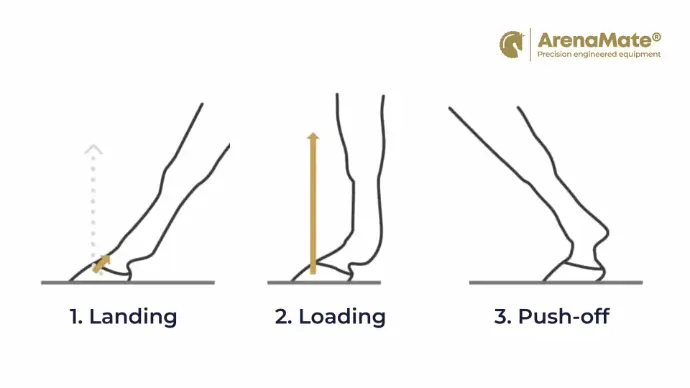Understanding Equine Footfall: How Surface Quality Impacts Performance and Soundness
When it comes to riding horses, whether competitively or for leisure, every stride counts. Whether it’s dressage, show jumping, or everyday schooling, the horse’s interaction with the surface beneath it can mean the difference between optimal performance and long-term injury.
Every equestrian understands the impact surfaces have on a horse’s movement and performance: we use roadwork to build bone strength, and an arena surface to support performance. But what if the surface we rely on most is failing us without our realising? What if it’s doing more harm than good, subtly altering our horse’s movement over time and contributing to injuries such as tendon and ligament damage?
At ArenaMate®, we know that footing is far more than just the material beneath the hoof. It plays a pivotal role in the biomechanics of every stride. In this blog, we take a closer look at the three essential phases of footfall, landing, loading, and roll-over/push-off, and how different surface properties influence each stage.
The Three Phases of Footfall
Every stride a horse takes involves a finely tuned sequence of biomechanical events. Broadly, each step is broken down into three key phases:
1. Landing: This is the moment where the hoof makes initial contact with the ground. During landing, the limb decelerates the body’s forward motion, and significant forces (up to 2.5 times the horse’s body weight) are transmitted through the joints and tendons (Chateau et al., 2010).
2. Loading: After contact, the weight of the horse is transferred onto the limb. The fetlock and supporting soft tissues flex to absorb the shock, stabilise the leg, and prepare for propulsion.
3. Roll-over/Push-off: The final phase sees the hoof rotate forwards and push off from the toe. Energy is transferred through the limb and into the surface, propelling the horse into its next stride.
These three phases are intrinsically linked, and the surface on which a horse moves has a direct impact on each.
How Surfaces Influence Each Phase of Movement
Landing
During the landing phase, a surface must be able to dissipate energy effectively to reduce peak impact forces. Surfaces lacking in shock-absorbing qualities can result in greater strain on the horse’s musculoskeletal system, increasing the risk of joint degeneration and microtrauma over time (Setterbo et al., 2009). Ideally, the top layer of an arena should compress slightly on contact, helping to mitigate impact without destabilising the limb. This environment can be created through even irrigation of the surface, either through the use of sprinklers or underground irrigation systems like the HIT Active Aqua.
Loading
As the limb fully loads, the surface must offer supportive resistance. A surface that’s too hard can prevent adequate cushioning, transferring excessive force back into the tendons and ligaments. On the other hand, overly deep or loose footing can cause instability, forcing the horse to compensate with abnormal limb motion. Studies have shown that uneven or inconsistent footing can alter stride mechanics, leading to muscle fatigue and overcompensation injuries (Hobbs et al., 2014).
Push-off
In the push-off phase, the horse relies on the surface to provide traction and return some of the energy stored during loading. High-performance surfaces are engineered to ‘give back’ some of this energy, enhancing performance while reducing fatigue. Too much give, however, and the hoof may sink, delaying propulsion and potentially leading to hyperextension of tendons, particularly the superficial digital flexor tendon, a common site of injury in performance horses.

Long-Term Impacts of Poor Surface Management
Over time, the wrong type of surface (or even a good surface poorly maintained) can have serious implications. Surfaces that become deep and dry due to poor water irrigation create excessive hoof sinkage, increasing strain during push-off and elevating the risk of long-term tendon injuries. In fact, research from Murray et al. (2010) highlighted a significant correlation between deep footing and increased incidence of soft tissue injuries, particularly in show jumping and eventing.
Inconsistencies in footing, such as compacted patches or excessively loose areas, can also lead to asymmetrical loading of the limbs, encouraging uneven muscle development and compensatory movement patterns. Left unchecked, these issues may lead to chronic lameness.
Maintenance and Water Irrigation
While the composition of your surface is vital, maintenance and moisture control are equally crucial. Regular levelling helps prevent compaction and maintain evenness, while correct watering ensures the surface remains supportive.
In Summary
Understanding how the three phases of footfall interact with your arena surface is key to protecting your horse’s soundness, improving performance, and avoiding injuries. At ArenaMate®, we’re committed to helping riders, trainers, and yard owners achieve optimal surface conditions all year round, because when the footing is right, everything else, like training and performance, can follow.
Got a question about arena maintenance?
Reference List
Chateau, H., Degueurce, C., Denoix, J. M. (2010). "Three-dimensional kinematics of the equine distal forelimb: Effects of ground surface." Veterinary Journal.
Setterbo, J. J., et al. (2009). "Surface effects on racehorse injury and performance: A biomechanical perspective." Equine Veterinary Journal.
Hobbs, S. J., Richards, J., et al. (2014). "Effect of surface on stride characteristics in galloping Thoroughbreds." Comparative Exercise Physiology.
Murray, R. C., Walters, J. M., et al. (2010). "Surface properties, limb kinematics and tendon strain in horses during jumping: Risk factors for injury?" Equine Veterinary Journal.